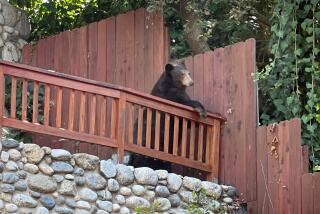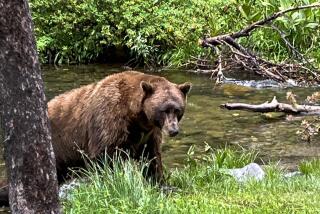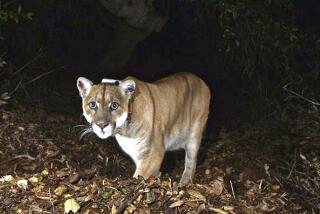An Uneasy Summer in Alaska : Nature: In the last of the wild lands where bears roam free, recent incidents-- including two deaths--have bitterly divided the public.
- Share via
ILIAMNA, Alaska — No one is sure when Binky, the 20-year-old polar bear in the Anchorage zoo, swept beyond the ranks of ordinary bruins and became a state hero. Most likely it was last summer, when he grabbed the leg of an Australian tourist who strayed too near his cage and--after the shrieking visitor escaped--paraded in triumph with the woman’s tennis shoes dangling from his mouth.
“Binky for Governor” T-shirts were sold all over Alaska. Even more popular were the ones with the “Binky Catch and Release Club” emblem.
So it was no surprise that when Binky died in July, the victim of a mysterious infection, Alaska went into mourning.
Flowers and notes were posted around the pen, which visitors could walk through unchallenged for the first time since Binky arrived as an orphaned cub. The Alaska Zoo opened its doors free for the tributes. Piles of tennis shoes were stacked outside the pen, next to one of the Australian tourist’s shoes--complete with tooth marks etched in the heel.
Binky’s death marked the low point in a long, uneasy season for Alaska’s bears and the growing number of visitors who tramp into their domains--a violent summer of attacks and reprisals that has left Alaskans debating the nature of their relationship with the beast that has always symbolized the wildness around them.
The most controversial incident took place along the Newhalen River near Iliamna, where a German tourist was mauled by a grizzly bear that shredded his tent, stepped on his head and bit his arm. The next day, five grizzlies, including a nursing sow and two cubs, were found shot to death near the banks of the river.
The cases have prompted many Alaskans to demand why state game officials have not moved aggressively to hunt down and kill bears responsible for attacking humans. Others--outraged at the grizzly shootings--say Alaskans must leave more room for their bears. At issue for many is the survival of these lumbering giants amid an increasingly resentful public in the last wild lands where the bears roam free.
The Anchorage Daily News is calling it “the summer of the bears.”
“The knowledge that we share this land with powerful, sometimes dangerous forces adds much to the intensity of Alaska life. It is the basis of our fascination with bears,” wrote Managing Editor Howard Weaver, explaining to readers why the newspaper came close to publishing five bear stories on its front page recently.
Wildlife officials say bears have always been a problem during two narrow windows in the summer season: when they emerge ravenous from their winter hibernation and again between the midsummer salmon runs and the fall berries.
“It’s kind of nice to know there’s something out there that’s bigger than you, that could eat you. . . . You’re more on your toes. You’re more alive,” said Anna Means, who works at the Alaska Cast and Blast hunting camp, a remote outpost in the Stuyahak Hills where a grizzly bear recently charged an employee before retreating.
Even Glenn Cooperrider, a cook at Denali National Park who encountered a grizzly last month while hiking, was philosophical.
Cooperrider says he should have tried to scare off the inquisitive juvenile bear. But when the animal began huffing and pawing the ground, Cooperrider fell to the ground and played dead, prompting the bear to begin nosing him. “It really didn’t work because he wanted to play,” Cooperrider said. “He was biting on my backpack, he pulled out my coat and chewed it up and the tent too. Then he stuck his head underneath my arm and made direct eye contact with me.”
The bear rolled him over a few times, then pulled off his backpack and took it away. When the bear charged again, Cooperrider leaped up and lunged with his hunting knife, sending the bear scurrying into the trees.
Denali has the most aggressive bear management program in the country, requiring bear-proof food containers for all park visitors and undertaking “aversive conditioning” for problem bears who strut into camps. Instead of shooting or relocating them, park officials first try such things as yelling, firecrackers, pepper spray or even rubber bullets. They follow a problem bear for days to make sure it begins to associate humans with unpleasant experiences rather than food.
Since the program began in 1982, only two bears have had to be removed from the park. And cases of bear-human interaction, which reached a high of 40 in 1982, have dropped dramatically.
In the heavily used Chugach State Park, well-known marathon runner Marcie Trent and her son Larry Waldron were killed on the McHugh Creek trail when they stumbled upon a bear defending a fresh moose kill. State officials have dismissed the case as one of unfortunate timing and say the bear was acting as a bear can be expected to do.
But Trent’s family and others have complained that the state should have hunted down and shot the bear.
“They come out with these statements saying [they] don’t think this bear poses a threat,” said Steve Waldron, Trent’s other son. “I admit the bear was just defending his kill, but I don’t see how they can possibly say that a bear that kills somebody is not more likely to do it again.”
Waldron has taken a beating locally. Letters to newspapers have attacked him for calling for the bear to be shot. “It’s just amazing all these people really seem to care more about bears than people. The worst one was a few days ago; it said I should stop whining. I just buried my mother and my brother, and they say I should stop whining and move to L.A.?”
Waldron said he has helped ease his pain by going back into Chugach Park with his 14-year-old nephew--who was with the pair when they were killed--to retrace their last steps. He took a gun. “Sometimes, I go in carrying two guns. There was a certain element of fear and revenge that first day. I go back in there and . . . I just stand there in this beautiful valley. And I think, Alaska, it took so much from me, but I still love it.”
*
Large numbers of Alaskans--especially in the rural villages--believe that strict hunting limits and other protections have left the state with too many bears. They say villagers are paying for protections demanded by urban animal-rights groups.
In Iliamna and the neighboring village of Newhalen, bears strolled fearlessly through the villages all summer, drawn by a record number of salmon swimming up the Newhalen River.
At the Newhalen rapids, where the German tourist was mauled, the bears were lapping up fish guts left on the banks and standing side by side with fishermen in the water. Many of the fishermen were horrified the next day when five grizzly bears were found nearby. They had been shot to death.
One lodge owner in Iliamna called it “a tragedy, a massacre . . . a slaughter” and demanded punishment for the unknown perpetrators. Friends of the Animals also protested, and Tim Moffatt, then the animal-rights group’s Alaska representative, dismissed villagers’ protests that the bears were becoming pests.
“There is still that parochial attitude on the part of Alaskans that it’s our game, our fish and we’ll do as we please,” he complained.
But James Lamont, vice president of the Newhalen Tribal Council, said villagers were defending themselves from the bears as they always have. He said the investigation into the bear shootings, in which fines of up to $25,000 and five years in jail could be imposed, threatens to pit natives and non-natives against each other in the small village of about 200 people.
“The Indian tribes believe they can take care of things themselves. There were too many bears, and they were getting into places where they shouldn’t be,” he said. “People were going to do something long before the mauling. The bears were getting out of hand . . . and we don’t need white people coming in and telling us what to do about it.”
*
One recent afternoon, half a dozen bears lined up next to fishermen along a rocky creek, grabbing the red fish that choked the icy waters. Three large bears and a pair of fishermen shared a sandbar in the middle of the creek, seemingly oblivious to one another.
Dell Bakke, a bush pilot who tracks wildlife for hunters and fishermen, swooped down for a closer view and chased a bear from midstream into the adjoining brush. He said bears and men will fish together as long as they share the same wilderness. And some may not survive the partnership.
“When they’re feeding, bears just for the most part lose their fear of everything and everybody,” he said. “They do what they want to do, when they want to do it, without any consideration of anything else.”
More to Read
Sign up for Essential California
The most important California stories and recommendations in your inbox every morning.
You may occasionally receive promotional content from the Los Angeles Times.










